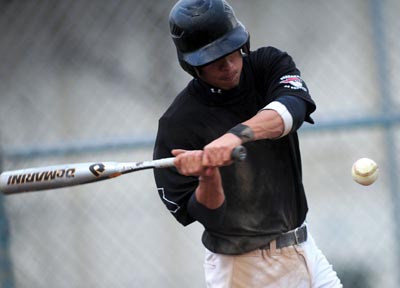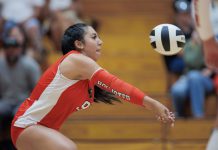
Balers get hands on BBCOR bats, which expectedly offer less pop
than last season’s counterparts
HOLLISTER
Even from his perspective in the San Benito dugout — not on the mound or in the batter’s box, which would offer more of a first-hand experience — Baler manager Jason Bugg can notice a difference in offense with the new bat standards, although a sizable variation in hitting was to be expected this season.
The new BBCOR (ball-bat coefficient of restitution) certification for non-wood baseball bats is in place this year for California high schools, and without having played an official game just yet, the results are in: Pitchers love them, hitters not so much.
Follow Free Lance Sports on Twitter.
Batted balls that were home runs a year ago are now doubles; doubles now have the chance of being caught. Pitchers, meanwhile, are expected to reap the benefits.
“The ball will take off, but it kind of dies. It doesn’t accelerate,” said Bugg, who is in his first year as San Benito’s varsity skipper.
“If you hit it in the right spot, it’s gonna jump,” he later added. “But home runs won’t be questioned. They’ll be earned now.”
Adopted one year ahead of schedule by the California Interscholastic Federation, the state’s governing body for high school athletics, the switch in bat standards last August came on the heels of a statewide discussion on the safety of aluminum bats after a pitcher from Marin Catholic was nearly killed from a line drive to the head.
As a result, the new BBCOR certification is said to measure the “trampoline” effect of a batted ball — not the exit speed of the previous BESR (Ball Exit Speed Ratio) standard — and is designed to replicate more closely the performance of a wood bat.
Darin Gillies, who is expected to be San Benito’s No. 1 pitcher this spring, said he never felt threatened by a hard-hit come-backer while on the mound, but welcomes the new bat standards — for obvious reasons — nevertheless.
“If you’re gonna play, you’re gonna take a risk. I didn’t feel it was necessary for them to make changes … I didn’t really feel threatened with the old bats” he said. “But it definitely helps (the pitchers) out. Teams won’t be able to rely so heavily on the long ball anymore.”
Which is where the most distinct difference lies with the new bats — the pop.
“The ball just doesn’t come off the bat as far,” Gillies said. “As pitchers, we’re happy.”
Added starting pitcher Bryan Granger, “Guys will put good swings on a ball, but it just dies.”
Although San Benito’s regular season won’t start until Feb. 24 at Valley Christian, two weeks of practice and tryouts with the new bats has yielded enough of an impression on the Baler players.
“You can totally tell that balls aren’t flying off the bat as they were with the regular (BESR) bats,” senior Dustin Rovella said. “It kind of feels like it’s dead. You kind of have to hit it on the sweet spot.”
Rovella said he considered actually hitting with a wood bat prior to this season, thinking the new BBCOR bats would offer little power.
“It has pop,” he added. “You just have to hit it right. It makes you a better hitter.”
The CIF has approved a list of nearly 200 BBCOR-certified bats already, while solid, one-piece wood bats have been approved as well. Composite wood bats are also allowed, although they must carry the BESR certification.
Meanwhile, for this year only, the CIF has also approved at least 30 bats that fall within the BESR-ABI standard, which includes the Accelerated Break-In procedure. Rovella said San Benito has one, and although it’s not on par with last season’s bats, it’s still better than the BBCOR alternative, physics aside.
“Everyone is using it,” he said. “It’s got a little more pop.”
If anything, the new standards should change the way the game is played. With the new bats acting more like wood bats, the result will likely be better, more disciplined hitters at the plate, lower-scoring games at the start, and a push toward small-ball for the foreseeable future.
“Small ball is good because it keeps defenses on their toes,” Bugg said. “We’re gonna prepare defensively for it, too. We have to expect they will play small-ball against us.”
Bugg said San Benito plans on scoring one run each inning, and it will utilize the small-ball approach to manufacture runs through stealing, bunting and timely hitting.
A home run would work, too. But players aren’t expecting to connect on as many round-trippers this season, at least not at the frequency of years past.
Said Rovella, “The bats are killing us on the long ball, so it’s more about the small ball now.”
Related Stories
High school baseball must switch to safer bats next year
Coaches chime in on new bat standards
Wood-bat debate hard to ignore, difficult to solve









